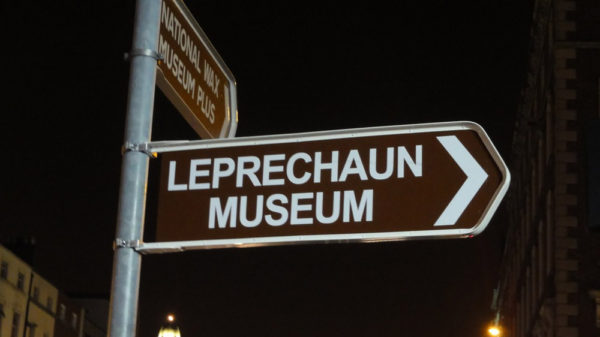Few icons from folklore and mythology have been branded and are more recognisable than the leprechaun; with stories of their rare appearance and treasured pot of gold still circulating around popular culture today – in fact, according to Irish Central, 1/3 of Irish people believe leprechauns exist.
But do we really know the true history behind leprechauns? How much of our knowledge is based on our celebrations of Saint Patrick’s Day? With this in mind, check out the real background to leprechauns, how they differ from our traditional perception and the influence they’ve had on modern culture.
Where Did Leprechauns Come From?
According to ‘The Element Encyclopaedia of Magical Creatures’ leprechauns can be traced back to eighth century tales of water spirits called “luchorpán,” meaning small body. This legend eventually evolved into a mischievous household being said to haunt cellars and drink heavily.
The earliest known reference to the leprechaun appears in the medieval tale known as the Adventure of Fergus son of Léti, in which Fergus mac Léti, King of Ulster, falls asleep on a beach and wakes up to find himself being dragged into the sea by three luchorpán. He eventually captures his abductors, who grant him three wishes in exchange for release.
Facts about Leprechauns
Their Appearance:
Although we have perceived that leprechauns wear green clothes, short hats and have a red beard, their original documented appearance differs significantly. According to Samuel Lover’s book the ‘Legends and Stories of Ireland’ (1831), Ireland’s ancestors depicted leprechauns as short individuals dressed in red with a cocked hat or a tri-cornered hat:
“… quite a beau in his dress, notwithstanding, for he wears a red square-cut coat, richly laced with gold, and inexpressible of the same, cocked hat, shoes and buckles”.
There Are No Female Leprechauns:
Leprechauns are always male. According to the book ‘Fairy Legends’ (1825), Leprechauns seem to be “entirely male and solitary”. The book also speculates that leprechauns are the offspring of fairies who were deemed “defective children…because of their shape and disposition”.
They Are Fairies:
Leprechauns might not match your initial description of a fairy, but they are considered part of the family, for they are small in size and prone to mischief. The miniature men are believed to be descendants of Tuatha De Danann, a group of magical beings that served under the Gaelic goddess Danu. Legend depicts how this mythical group lived in Ireland long before humans inhabited the land.
There Are Earlier Folk laws:
Although Ireland has become notable for popularising the legend of leprechauns, these weren’t the first stories centring on small beings. For example – Holland has the Kabouter, a small “gnome-like” creature that creates shoes.
They Reward Kindness:
Leprechauns are traditionally perceived to be mischievous and sneaky, but they can be generous when shown kindness. One legend depicts how an unlucky nobleman who offered a leprechaun a ride on his horse returned to his decaying castle to find it filled to the ceiling with gold.
They Have a Troublesome Cousin:
The boisterous Clurichaun is a mythical creature that shares several characteristics with the leprechaun. Also wearing red, these being are continually explained to be the drunken night-form of leprechauns, for after a after a hard day’s work, the leprechauns become so tipsy they transform into an entirely different species. Clurichauns are often seen riding animals at night or clearing out entire wine cellars in stories.
How Have They Impacted Culture?
They’re protected Under European Law:
Thanks to a group of lobbyists from Carlingford, Co. Louth, leprechauns and their heritage are protected under European law. The directive derived from an effort to preserve the rich bio-diversity of the area called ‘The Sliabh Foy Loop’; which is now a protected area for flora, fauna, wild animals and leprechauns. Woods – one of the original members from the group explained how there are only 236 leprechauns left in Ireland on Foy Mountain at Slate Rock. They also believe this place is of the spirit world. Perhaps there should be some casino odds against these claims.
There’s a Leprechaun Colony in Portland, Oregon:
When journalist Dick Fagan noticed a small circular pole in concrete where a light pole was missing, he took it upon himself to provide a purpose. After adding flowers and a tiny sign that proclaimed it the “world’s smallest park,” Fagan started to write stories about the spot in a newspaper column, where he detailed the adventures of a small leprechaun colony led by a leader only visible to Fagan. On St. Patrick’s Day in 1976, the unique garden became an official city park and over the years has had miniature additions like a swimming pool complete with a diving board.
Dublin’s Museum for Leprechauns:
The National Leprechaun Museum in Dublin is the first ever attraction dedicated to Irish mythology, folklore and enchanting stories. Upon entering the museum, a guided tour will provide information on Irish folklore and mythology and allow you to explore areas that reflect the stories and recreate experiences that are typically associated with leprechauns – from the first ever sighting back in the eighth century, through to modern day representations of the leprechaun in film and popular culture.
Do you believe in leprechauns? Let us know below…

